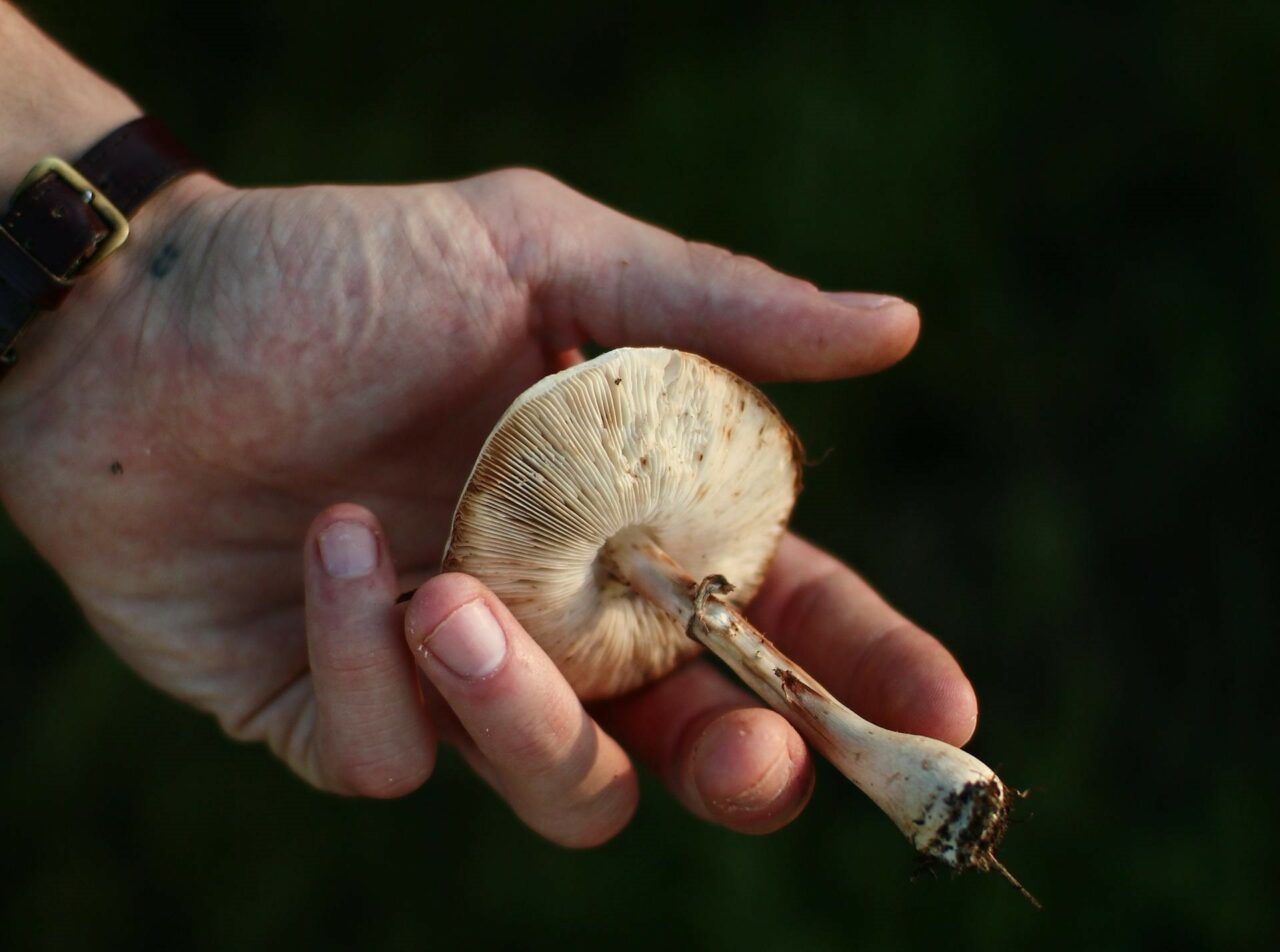Psilocybin mushrooms, akin to LSD in their role as a serotonin 5-HT2A receptor agonist, are a conventional type of psychedelic. They are currently under examination in studies for psilocybin-assisted therapy for mental health issues such as emotional distress related to major depression, anxiety, cluster headaches, and migraines.
To understand the beneficial role shrooms can play in these disorders, it is essential to analyze their metabolization process within the body. This knowledge allows both researchers and users to understand how the active compound produces psychological and therapeutic effects. This article gives a basic overview of psilocybin’s pharmacology and pharmacokinetics.
[toc]
Key Points:
- Half of the psychedelic fungi consumed orally is absorbed and distributed throughout the body.
- The compound within the fungi undergoes dephosphorylation through the enzyme alkaline phosphatase, primarily in the liver.
- Approximately 3.4% of the compound is expelled in its original form within 24 hours, with the majority being excreted as a stable metabolite.
What is Pharmacokinetics?
Pharmacokinetics (PK) is the branch of science that studies how substances, such as drugs, are processed by the body once they are ingested. It is distinct yet related to pharmacodynamics, which looks at how a compound interacts with the body. PK focuses on four main aspects: absorption, distribution, metabolism, and excretion (ADME).
Understanding these processes aids healthcare professionals in prescribing the most effective medications with the least risk. It also allows them to personalize treatments based on each patient’s unique physiology and lifestyle.
How is Pharmacokinetics Relevant to Psilocybin?
Psilocybin and psilocin, the primary active compounds in certain magic mushroom species, have drawn significant attention from researchers and users alike. Pharmacokinetics studies how the body manages mushrooms containing psilocybin, aiding in understanding their potential effects, whether for medicinal or recreational purposes.
These compounds are identified by various names, including “magic,” “psychedelic,” “medicinal,” or “sacred.” The fungi containing these compounds are consumed, with The mushroom varieties, their place of origin, size, growth and drying conditions, and their age can significantly alter their psilocybin concentrations.
While these mushrooms naturally exist in the wild, scientists have developed techniques to produce them in a laboratory setting. Both the naturally occurring and lab-grown versions exhibit low toxicity. However, minor side effects such as nausea or vomiting might still occur.
Despite these minor physical side effects, the compounds in these mushrooms have exhibited potential therapeutic advantages due to their safe profile and non-addictive nature. These advantages have spurred research into their potential application in psychotherapy, specifically for the treatment of anxiety and depression.
The Four Stages of Pharmacokinetics
Psilocybin, the active compound in these mushrooms, is initially inactive and acts as a prodrug, transforming into its active form, psilocin. Enzymes such as alkaline phosphatase facilitate this conversion, allowing psilocin to be absorbed and distributed throughout the body, reaching various tissues. However, after oral administration, psilocybin cannot be detected in the circulatory system, feces, or urine.
Absorption
Absorption is the process by which the compound enters the bloodstream from its administration site. This process impacts the rate and efficiency at which the compound reaches its intended target, such as the plasma. The most common route of administration is oral. Inhalation has been attempted, but it’s not as effective as oral intake.
The absorption process also entails the release of the compound from the dosage form during oral ingestion. Elements like a delay in the throat or esophagus can affect this, potentially slowing down the effects or causing discomfort. Once the compound reaches the stomach, the acidic environment may start to break it down before it enters the bloodstream.
Studies conducted on animals indicate that only about 50% of orally administered psychedelics are absorbed and distributed throughout the body.
Factors Affecting the Absorption Process
Several variables can affect the absorption process, leading to variations in the onset, intensity, and duration:
- Stomach Contents: A full stomach can delay the process as it slows down the onset of effects. Faster absorption is achieved on an empty stomach.
- Body Fat: Substances can potentially accumulate in fat tissues, which may prolong their effects.
- Age: Metabolic rates and body composition can vary with age.
- Zero-Order Kinetics: The substance is expelled at a steady rate, irrespective of its concentration.
- First-Order Kinetics: The elimination rate is proportional to the concentration of the drug.
The term distribution relates to how psilocin gets dispersed throughout the body once entering the bloodstream. Given its lipophilic nature, psilocin can traverse the blood-brain barrier to reach the central nervous system.
system.Various factors such as the substance’s size, polarity, and protein-binding capacity, along with a person’s physiological aspects like hydration levels and body composition, significantly influence this process.
The aim is to achieve an effective concentration at the target site. For optimal effect, the substance must arrive at the predetermined zone, as guided by the volume of distribution and remain unbound to proteins, allowing it to interact dynamically with its receptor.
What Factors Affect the Distribution Process?
Several elements can impact the distribution process:
Typically, the effects start to manifest about 20-40 minutes after consumption, peaking around 80-100 minutes. The effects of magic mushrooms generally last between 4-6 hours.
How Does the Brain Receive Psilocin?
An initial experimental study on two species demonstrated that its binding affinity sequence is 5HT2A > 5HT1A > 5HT2B [23]. It also interacts with dopamine D1, 5HT1E, 5HT5A, 5HT7, 5HT6, D3, 5HT2C, and 5HT1B receptors.
Psilocin acts as a partial agonist at the 5HT2A receptor, with an effectiveness of about 40%. Its psychedelic effects are likely due to its partial agonist activity at 5HT1A autoreceptors.
The enhancement of mood and psychotomimetic experiences might be linked to the noted relationship between raised dopamine levels and sensations of depersonalization and euphoria. Hallucinogens work by modifying neurochemistry and receptor activity. It increases 5HT2A agonist activity by boosting BDNF production in the hippocampus, consequently encouraging neurogenesis and reducing conditioned fear-related behaviors.
Elimination Process
Elimination refers to the process by which the The human body expels substances primarily through the kidneys, but also via the lungs, skin, and gastrointestinal tract. For instance, a naturally occurring psychedelic drug is filtered in the kidney’s glomerulus or secreted in the tubules, with some reabsorption further complicating the process.
The primary compound has an approximate half-life of 160 minutes, while psilocin’s half-life is around 50 minutes. Animal studies indicate that this is mainly excreted through urine, accounting for about 65% within 8 hours. Even after consumption, small amounts of the substance can be found in bile and feces.
In the human body, about 3.4% of the substance is excreted in its original form within a day, while most of it is eliminated as psilocin-O-glucuronide, a more stable metabolite. This stability allows the compound to be detectable in urine samples for a longer duration.
The two primary methods of substance elimination are:
Most psychedelic drugs follow the first-order kinetics method, reaching stable concentrations after four to five half-lives. Complete removal also happens after four to five half-lives.
Browse Our Range of Hallucinogenic Mushrooms
The metabolism process varies with different types of fungi. By buying from reliable online vendors such as Shrooms Near Me Canada, you can avoid the risk of consuming poisonous mushrooms. Some varieties like Agaric mushrooms can produce strong, undesirable effects. Therefore, it is essential to procure magic mushrooms from trustworthy dispensaries, rather than risking it with street dealers or wild foraging.
| Feature | Enigma | Full Moon Party | Gold Member | |
| Strain Type | Psilocybe Cubensis OMNI | Psilocybe cubensis (Thai Koh Samui) | Psilocybe cubensis | |
| Potency | Exceptionally high; 3.8% tryptamine content | Moderate to high potency | High potency | |
| Visual Characteristics | Resembles a blob or | Resembles a cauliflower or brain | Classic cubensis look; moderately sized | Thick white stems; caps in golden caramel; clear evidence of blue bruising |
| Effects | Known for extreme potency; triggers intense effects | Powerful cerebral high; onset is slow but visuals are prominent | Produces strong visuals and feelings of euphoria |
Online Guide to Psilocybin Mushroom Usage
Understanding how shrooms work within the body is crucial for medical professionals, researchers, and users alike. This knowledge allows for safer decisions regarding dosage and timing, reducing potential risks.
Discover your perfect psychedelic journey at Shrooms Near Me Canada. Whether you’re after a soothing voyage or a deeper exploration, our wide array of products is tailored to meet your unique needs. Enjoy top-tier, secure, and quality-assured shrooms, without having to worry about questionable sources or poisonous varieties.
Experience the best magic mushrooms Canada has to offer and take your psychedelic adventure to heights never before reached.
Frequently Asked Questions
Do shrooms interact with other medications?
Our products may interact with certain medications, particularly those affecting serotonin levels, such as SSRIs (Selective Serotonin Reuptake Inhibitors). SSRIs and SNRIs (Serotonin and Norepinephrine Reuptake Inhibitors) generally decrease the effects, unlike non-serotonergic antidepressants. This reduced effect can last up to three months after stopping the use of the antidepressant.
Do all psychedelics follow the same process as psilocybin?
No, each psychedelic substance has a unique structure that requires different metabolic processes to activate, and they attach to various receptors in the body. The way the psychedelic is administered also affects absorption. Although the basic principles of absorption, metabolism, and distribution are constant, the specific pathways and effects vary for each substance.
Does the form of the shroom affect its pharmacokinetics?
Yes, the form (whether fresh, powdered, or dried mushrooms) can affect the absorption rate. For example, powdered forms might be absorbed faster than whole dried ones due to quicker dissolution.
Further Reading:





